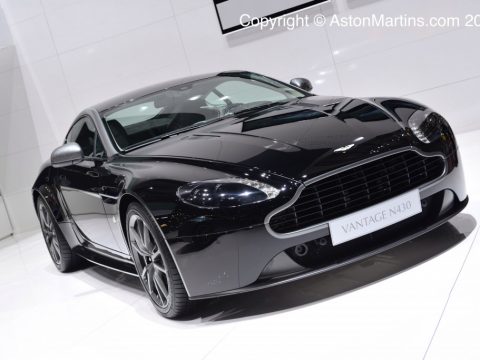The potential problems with this new two car strategy were not apparent until the new AML CEO, Dr Ulrich Bez joined the company in July 2000. On the second day as CEO, Dr. Bez axed the mid-engined 2 seater, despite it already having apparently been approved by Ford Top Brass. Dr Bez was very much against mid-engined Aston Martins and cost-cutting parts sharing with marques within the Ford empire.
As a result, by the end of 2000, the master plan for Aston Martin was re-written; AML would use Ford resources to develop a totally new and unique bonded and riveted aluminium platform which could easily be be made in differing lengths for different cars in the range. Thus the sportscar AM305 could have a shorter wheelbase than the larger GT AM803 and yet share very many key components with each other but not with other cars in the Ford portfolio. This platform, now known as VH architecture, previewed on the AMV8 Vantage show car and was used on the DB9, DBS, V8 and V12 Vantage, Rapide, Virage, Vanquish and AMR race cars.
VH stands for Vertical/Horizontal and is nothing to do with the orientation of the components. ‘Vertical’ represents the vertical integration of the platforms components both up and down the AM range. ‘Horizontal’ represents the horizontal spread of platform concept across to the other Ford brands, although once AML became independent, this didn’t actually happen. The really clever thing is that since the outer body panels are not structural, it allowed for inexpensive restyles and very special editions.
The DB9 was undoubtedly the star of the 2003 Frankfurt Motor show where it was unveiled to the public for the very first time. The sleek superformed aluminium body was designed by Ian Callum but had some additional work by the next director of AM design, Hendrik Fisker. The DB9 is powered by a third generation version of the now familiar 6.0 litre V12 and has a top speed of 186mph. Production of the coupe started at the new Gaydon factory very early in 2004, with the DB9 Volante coming on stream early in 2005.
The Geneva Salon 2005 was the venue for the unveiling of the fabulous V8 Vantage with styling previewed in the AMV8 Vantage concept; the first in what has become a very exciting line of two seater sports cars. Production of the 175mph machine begin in the Autumn of 2005 to satisfy the desire of many anxious new owners. A Roadster version was unveiled in November 2006 for production began mid way through 2007. Midway through 2008, the engine grew in capacity from 4.3 litres to 4.7 litres with peak power jumping to 420bhp. The V8 Vantage S was introduced in 2011 with it’s 7 speed Sportshift II transmission and engine uprated to 430bhp. By 2012, the regular V8 Vantage received a host of updates first seen on the S model including the optional 7 speed transmission.
And a potential third model line was first seen at the Detroit Motor Show in January 2006. Unveiled as a running concept, the Rapide is not a Lagonda, but a 4 door hatchback Aston Martin sportscar. The production Rapide, was then unveiled at the Frankfurt Motor Show, 2009 and series production began at the Magna Steyr specialist facility in Graz, Austria. Deliveries to customers began in Spring 2010.
Another addition to the quickly growing range was the DBS, a derivative of the DB9, V12 powered and first seen as transport for James Bond in his 21st film, ‘Casino Royale’. The production car was introduced at the Pebble Beach Concours d’Elegance in August 2007 with a convertible Volante breaking cover 18 months later. The DBS continued to be the ‘top of the range’ of the VH cars until 2012.
More recently, Aston Martin has managed to take their biggest engine and squeezed it into the smallest bodyshell to create the V12 Vantage. Initially seen as a fully running concept, production began in late Spring 2009 and the car sold strongly around the world. Eventually the V12 Vantage Roadster was announced in July 2012 with a very short run of only 101 production cars. During Centenary year, the popular V12 Vantage was superseded by what was heralded as the fastest production Aston Martin ever, the 565bhp, 205mph, V12 Vantage S.
In order to bridge the gap in the range between the DB9 and DBS, at Geneva in 2011, the Virage was introduced. With the refinement of the Rapide but a more focused driving experience from the DBS, the Virage has become the GT of choice. The Virage only lasted in production for a year before it was replaced by the ‘new’ DB9 MY2013.
Also announced in 2011, the V12 Zagato, based on the V12 Vantage – initially as a concept – but within a week of being announced, being raced at the Nürburgring. Series production was announced a little while later with a limited edition run. Deliveries of the new Zagato began in the Autumn of 2012 an a UK price of almost £400,000.
Mid 2012 and with the 100th anniversary of the birth of Aston Martin only a year away, AML unveiled the first of the 4th generation of VH cars to replace the DBS, the Project AM310. A short while later, the car was more formally announced as the new Vanquish. The Vanquish Volante was launched during Centenary Week, July 2013.
VH car production continued with sales of both V8 and V12 cars for most of the decade until the DB9 was replaced by the DB11 and the VH2 Vantage replaced by the AM6 Vantage. The final VH car to be built was the run out Rapide AMR which ended during 2019. The Rapide might have carried on a little while longer with electric power until put on hold in 2020.















